Strategies for Reducing Waste in Your Ecommerce Operations
In recent years, environmental sustainability has gained paramount importance, compelling businesses across all industries to minimize their ecological footprint. For ecommerce businesses, this translates to implementing measures that reduce waste throughout their operations.
Why Waste Reduction Matters in Ecommerce
Ecommerce operations generate substantial waste, ranging from product packaging to shipping materials and returns. Reducing waste not only decreases a business's carbon footprint but also conserves resources and lowers operational costs. According to the EPA, efficient waste management can lead to significant cost savings and enhanced brand reputation.
Implementing a circular economy model is one effective strategy. This involves designing products and packaging with reuse or recycling in mind, thereby reducing the overall waste generated and fostering a sustainable business ecosystem.
Additionally, optimizing packaging and shipping processes can enhance operational efficiency. Streamlined processes reduce the time and resources required for order fulfillment, leading to faster delivery times and improved customer satisfaction.
The Environmental Impact of Ecommerce Waste
The environmental repercussions of ecommerce waste are profound, contributing to pollution and climate change. Excessive packaging materials and single-use shipping supplies exacerbate these issues, making waste reduction imperative. By minimizing waste, ecommerce businesses play a crucial role in mitigating environmental degradation.
Returns significantly contribute to ecommerce waste. Each returned item often involves additional packaging and transportation, increasing the overall waste footprint. Adopting sustainable return policies, such as encouraging customers to reuse packaging or donating returned items, can substantially reduce this waste. According to a study by NCBI, improving return processes can lead to a 20% reduction in packaging waste.
The Financial Benefits of Reducing Waste in Ecommerce
Waste reduction offers tangible financial benefits to ecommerce businesses. By minimizing packaging size and utilizing cost-effective shipping materials, companies can significantly lower their expenses. Implementing recycling programs also reduces waste disposal fees, contributing to overall cost savings.
Moreover, embracing sustainability can enhance customer loyalty. Today's consumers are increasingly eco-conscious and prefer brands that prioritize environmental responsibility. A report by Nielsen indicates that 73% of global consumers would definitely or probably change their consumption habits to reduce environmental impact.
By adopting eco-friendly practices, ecommerce businesses can attract and retain customers, leading to increased sales and revenue growth.
Effective Strategies to Reduce Waste in Ecommerce Operations
Conducting a Waste Audit
The initial step in waste reduction is performing a comprehensive waste audit. This involves analyzing all facets of the business, from product packaging to shipping materials and return processes, to identify waste generation points. Understanding the volume and sources of waste enables businesses to develop targeted strategies for waste minimization.
Minimizing Packaging Waste
- Optimize Packaging Size: Use appropriately sized packaging to reduce material usage and shipping costs.
- Eco-Friendly Materials: Switch to recyclable or biodegradable packaging materials, such as bioplastics and recycled paper.
- Customer Options: Allow customers to opt-out of excess packaging and encourage recycling or reuse of packaging materials.
Sustainable Packaging Alternatives
Exploring sustainable packaging alternatives can significantly reduce environmental impact. Options include:
- Biodegradable Plastics: Made from natural materials like cornstarch or sugarcane, these plastics break down naturally over time.
- Recycled Paper: Utilizing recycled paper minimizes the need for virgin materials and conserves natural resources.
- Reusable Packaging: Implementing a closed-loop system where customers return packaging for reuse in future shipments.
Implementing Recycling Programs
Establishing recycling programs within ecommerce operations can drastically reduce waste. This involves setting up systems for collecting and recycling packaging materials, thereby diverting significant amounts of waste from landfills. According to the Waste360, businesses can save up to 30% on waste disposal fees through effective recycling initiatives.
Reducing Food Waste in Ecommerce
For ecommerce businesses dealing with food products, additional strategies are necessary to manage and minimize food waste:
- Donation Programs: Donate unsold or excess food products to local food banks or charities.
- Eco-Friendly Packaging: Use sustainable insulation materials to preserve food quality during shipping.
- Imperfect Produce Sales: Offer "ugly" or cosmetically imperfect produce at discounted prices to reduce food waste.
Minimizing Product Returns and Associated Waste
Returns contribute significantly to waste in ecommerce. To minimize returns and their environmental impact:
- Accurate Product Descriptions: Provide detailed and accurate product information to ensure customer satisfaction.
- Improved Sizing Information: Offer comprehensive sizing guides to reduce size-related returns.
- Repurposing Returned Products: Implement strategies to refurbish or recycle returned items.
- Incentives for Keeping Products: Offer discounts or rewards for customers who choose to keep their purchases.
Leveraging Technology to Reduce Waste
Technology plays a vital role in waste reduction for ecommerce businesses. Utilizing data analytics helps identify waste generation patterns and optimize processes accordingly. Automated packaging systems can minimize excess material usage, while digital invoicing reduces paper waste.
Additionally, adopting energy-efficient technologies in warehouses and fulfillment centers can lower energy consumption and reduce carbon emissions. Virtual try-on technologies for apparel and accessories can also decrease return rates by enabling customers to make more informed purchasing decisions.
Communicating Your Eco-Friendly Initiatives
Effectively communicating sustainability efforts is essential for building customer trust and loyalty. Businesses can showcase their eco-friendly initiatives through their website, social media platforms, and email marketing campaigns. Highlighting sustainable practices and offering eco-friendly packaging options can resonate with environmentally conscious consumers.
Partnering with like-minded organizations amplifies sustainability messages. For instance, collaborating with local environmental groups for community events can enhance brand reputation and reach a broader audience.
Transparency about sustainability goals and progress fosters customer trust. Publishing regular updates or sustainability reports on your website can demonstrate commitment and keep customers informed about ongoing efforts.
Educating Customers on Waste Reduction
Customer education is pivotal in fostering sustainable practices. Providing informative content on the environmental impact of waste and offering tips for reducing personal waste can encourage customers to engage in eco-friendly behaviors.
- Informative Content: Share statistics and facts about the environmental consequences of waste.
- Incentivize Sustainable Behavior: Offer discounts or rewards for customers who utilize reusable packaging or participate in recycling programs.
Measuring the Success of Waste Reduction Efforts
Tracking and analyzing waste reduction initiatives is crucial for assessing their effectiveness. Key metrics include the amount of waste generated, waste diverted from landfills, and cost savings achieved through waste minimization. Regularly reviewing these metrics allows businesses to identify areas for improvement and refine their waste reduction strategies.
Future Trends and Innovations in Sustainable Ecommerce
The landscape of sustainable ecommerce is continually evolving, with emerging trends and innovations driving further waste reduction:
- Advanced Eco-Friendly Materials: The development of new biodegradable and recyclable materials offers more sustainable packaging options.
- Enhanced Data Analytics: Improved data analytics tools facilitate better waste management and operational efficiency.
- Automation in Packaging: Increased automation leads to more precise packaging, reducing material waste.
- Renewable Energy Integration: Incorporating renewable energy sources in fulfillment centers lowers overall carbon emissions.
Staying abreast of these trends enables ecommerce businesses to continuously enhance their sustainability efforts and contribute to a more sustainable future.
Conclusion
By implementing these strategies for reducing waste in ecommerce operations, businesses can enhance their environmental sustainability, achieve cost savings, and boost customer satisfaction. Embracing sustainability not only protects the planet but also positions businesses for long-term success in an increasingly eco-conscious market.




















